After having driven the family Talisman, I think there's still a chance, and that it can be a successful model. A year ago Guille gave us the first notes that explain why the Renault Talisman is an interesting option for the D-segment. Back in August we got the first information about the Sport Tourer, which has now been presented to the Spanish press and is already on sale.
To begin with, the sedan and the estate have a lot in common, beyond the obvious. There is only 1 cm difference between the two, choosing the wagon doesn't mean having a significantly longer car, so they fit in the same garage space. While the estate doesn't have a bigger boot with all five seats able (up to the edge of the seats), it does provide more modularity, easier access, and more comfortable rear seats with 30mm more headroom. I haven't travelled in the back, but I'll leave that for reflection: there are two USB sockets in the rear area for charging gadgets, an insignificant detail, or not?
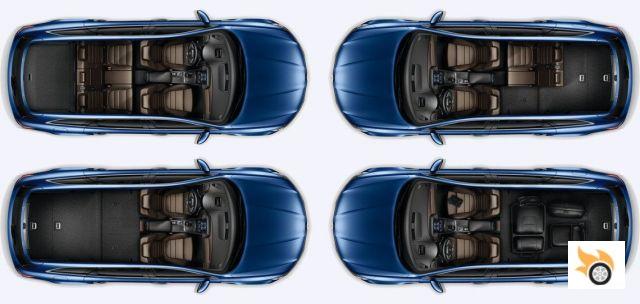
Here we can see the different trunk adjustments. The sedan has a capacity of 572 liters, that is, 36 liters more than the family car up to the seats or the flexible curtain. The load opening is 571 mm from the floor, and there are 1.12 meters from the edge to the back of the seats. If the seats were folded down, that distance increases to 2.06 metres, and the load volume jumps to almost 1,700 litres. This is where the estate wins by a landslide.
The estate has the advantage that the tailgate makes loading much easier, especially when it opens electrically. Optionally it has a system to open it by passing a foot under the bumper in case you have your hands full. A button allows you to limit the height, so as not to hit the roof of narrow garages. If pressed for three seconds, a stop is programmed, so that it does not rise to more than that height, the normal stop is 1.07 meters. A comment about the curtain: I don't like the mechanism to move it and leave it in a fixed position.
There are some solutions in the accessories to load and unload without damaging the boot.
Handles on the sides of the boot make it easy to fold down the second row seats, and if you want a completely flat load floor, the tray can be adjusted to eliminate the resulting small step. We also noticed two hooks for small bags, as well as compartments on the sides for those little things that are always loose. It's a bit hard to get to the bottom of the trunk, it's almost like descending into hell.
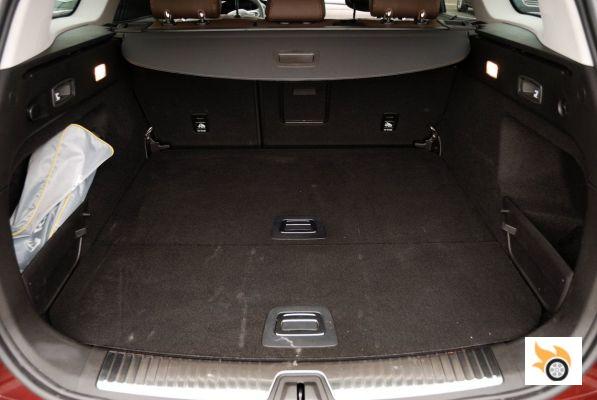
In the interior we will not find any difference with the sedan, I insist, beyond the obvious. I haven't driven the sedan, but I don't think you'll find any noticeable differences in the ride. The two cars have the same wheelbase, the weight difference is minimal, the nuance is in the aerodynamics; the sedan is cleaner, runs more and spends a little less. I dare say that an average driver would not notice the difference in feel, if a professional can find it hard to find it.
Therefore, most of the comments below are also applicable to the four-door Talisman. I'm used to change cars like a shirt, and I usually have an easy time finding things by simple professional deformation. That didn't happen to me with the Talisman, I felt a bit more lost in the first few minutes, it seemed less intuitive.
The steering wheel adjustment is not electric, the adjustment mechanism needs more refinement.
For example, the buttons that activate the speed regulator/limiter are practically at the opening of the central hood, and they are supposed to be activated on the move. The button that activates the different modes of the Multisense system (which changes different aspects of the car) is in an obvious place only if you've previously looked. The selector knob, similar to the one in the Mazda6, I barely felt like touching, I ended up making do with the R-Link 2 system's touchscreen instead. Underneath the knob is a refrigerated drinks compartment that can go unnoticed.
Both of the cars I drove were of the highest specification, Initiale Paris, which is equivalent to the more luxurious Vignale versions of the Mondeo. Despite the car being packed full of cool details, the price is far from exorbitant. The 160 hp diesel starts at 41,000 euros (0% RT) and the 200 hp petrol at 43,000 euros (4.75% RT), and in both cases the automatic transmission comes as standard. If we take out the difference in registration tax, due to CO2, the ex-works price will be almost the same. In a German Premium the money will be a lot less.
The 110 hp diesel in basic trim starts at 25,400 euros, no small print.
One of the highlights of the car is the Multisense system, which affects the behavior of the automatic transmission, piloted suspension, engine sound (artificially enhanced), electric seat massage, lighting color and design of the dials, behavior of the four-wheel steering (4Control), climate control, etc.. The 4Control system makes the car more agile when cornering, and more stable on the motorway. And that? We're talking about a shortening or widening of the wheelbase, and that has its consequences. German premiums don't have such a level of customization, let alone at the touch of a finger on a screen.
It's not just that there are several modes (Individual, Eco, Sport, Comfort and Neutral), it's that personal settings can be made for six drivers. So the different nuances change the driving experience in a way that's most satisfying to the person behind the wheel, depending on their mood or the road they're driving on. As far as I know, it's the only car in the D-segment that has that level of customization. Overall we're talking about a very good car, Renault says it's built to last - with advice from its Daimler partners - and we'll see that after a few years.
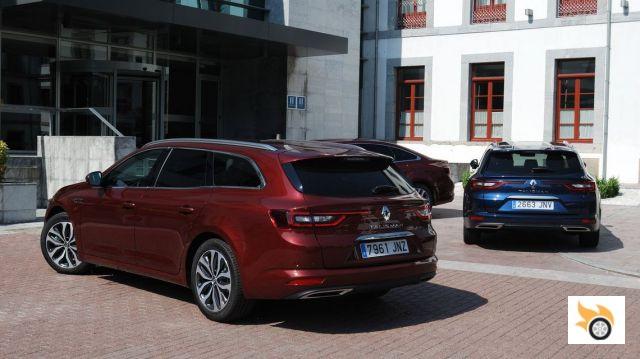
Petrol versus diesel
First I drove the 160bhp 1.6 dCi, which has twin sequential turbocharging. In English, a low inertia turbo boosts the engine at low revs, and a higher flow turbo pushes the engine at high revs. The engine is full of power along the tachometer without abruptness, with a level of refinement worthy of a V6 of a few years ago, due to how isolated it is. Even a petrolhead will be able to respect it.
It goes from 80 to 120 km/h in 8.7 seconds.
The differences in noise compared to the petrol are noticeable especially when accelerating hard, otherwise, I would say that almost tied. Curiously they are also very close in consumption, as driving in conditions not too similar the petrol spent only 1 l/100 km more. In theory, the 150 hp 1.6 TCe is like the 200 hp, but with a tweak. At a leisurely pace the two TCe's should perform very similarly. The smaller 1.6 TCe, which is turbocharged, delivers power appreciably less linearly than a 2.0, for example.
The 160 hp diesel is a very good engine in several ways. It gets 4.5 l/100 km, even as an automatic and estate car, so it doesn't pay registration tax. In reality, obviously, it does not spend so little, we can add a couple of litres more with a little demanding use, or a litre more in more favourable conditions. The 110 hp diesel is rated at 3.7 l/100 km, a little more and we're told that it has negative consumption and the diesel is magically regenerated in the tank...
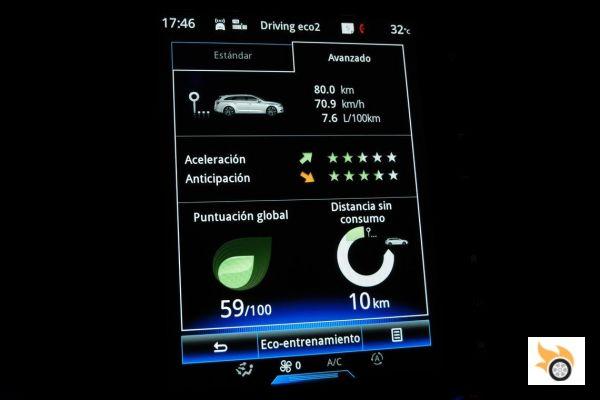
As for the 200 hp petrol, I like it in the sense that it has a very reasonable thirst, and has very good recoveries: only 6.2 seconds from 80 to 120 km / h with this body, and 5.9 seconds for the sedan. It steals the wallet in this measurement from the 150 hp TCe by almost two seconds! It also drops 30 seconds from 0 to 1,000 meters, which is a good figure. Accelerating to 100 km/h (62 mph) takes less than 8 seconds, the diesel needs one and a half seconds more. If we compare 160 hp diesel and 150 hp petrol, the difference in performance is very slight.
I have driven, like my test partner, mainly on the A-8 motorway in Asturias, with constant slopes and many radars. At a more relaxed pace and making little use of power, we got 7.6 l/100 km, with an efficient driving score of 59/100. With more power and at a higher pace than most people, the fuel consumption was 8.3 l/100 km, with a driving efficiency score of 51/100. It doesn't seem to be very usage-sensitive.
Both TCe's are rated at 5.8 l/100 km, which is very little for a car in this class.
Keep in mind that the TCe has a seven-speed automatic transmission, the diesel has a six-speed automatic, so the TCe has a more favourable gear ratio. Both engines are well used anyway. I find the performance/consumption ratio of the TCe more remarkable. It confirms one of my theories: the more satisfactory a petrol engine is in refinement, the more it consumes.
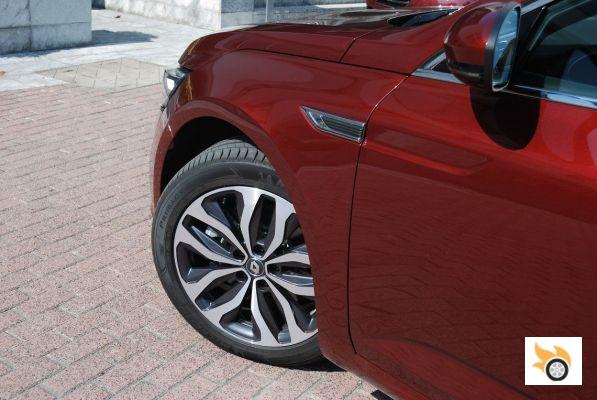
Travelling in this car is an experience similar to that of going to a spa, but with more clothes and without so many exotic aromas. It is a car to do miles at full speed, in comfort mode you feel like the faquin boss, while the seats give a massage, the suspension isolates what it can from the asphalt (it does what it can with the horrible grating of the A-8) and the stereo pampers our eardrums. Curiously, and it doesn't matter in which mode you drive, the steering feel of the diesel seemed different from the petrol, as if it was harder.
It doesn't have paddle shifters for semi-automatic gearboxes by commercial decision, but it has that function on the lever, with an unconvincing feel.
By the way, the audio system signed by BOSE with 13 speakers is very good, not only for the sound quality and purity, but also because you don't notice any parasitic vibrations in the car even if you turn up the volume a lot and the Maximum FM sounds. In that sense I found it clearly superior to the Ford Mondeo Vignale, or simpler sedans in pretensions as Toyota Avensis. The Initiale Paris has a snobbish touch that should not be lost sight of. It must also be said that the driving aids are a point behind: it does not correct the steering if we are going to leave the lane and does not warn well of the danger of driving close to others. At least it warns -and very well, by the way- of the presence of radars through the Coyote system. On the A-8 this is a godsend.
The car is very well insulated in every way, in fact the top of the range have double laminated windows and insulate a lot of the worldly noise. The air conditioning also does a lot, both hot and cold, the ventilation of the seats is something that was previously only in segment E / F and in summer the difference is abysmal. Seriously, this car has to be tested to talk about it fairly. The design lives up to what's inside the shell.
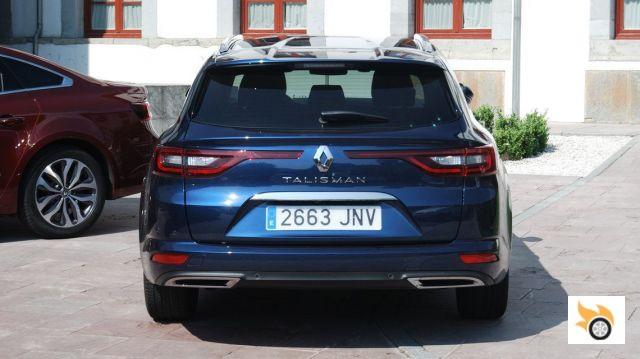
Now, what can we expect in the commercial life of this model? No more powerful engines, nothing over 200 hp has been planned, and neither will come the diesel-hybrid version because the engines have little homologation. I'm curious that the dCi engines do not use selective catalytic reduction (SCR), so I doubt their environmental credentials in real use, Euro 6 is met in the lab as required, and outside, so what?
The top of the range are all automatic (EDC), the manuals are reserved for the 110 and 130 hp diesels.
As for the impact the Koleos SUV could have next year in a classic segment like this, Renault bosses say they "don't have a crystal ball". It could be that the Koleos cannibalises sales, or that everything stays as it was. At the end of the day, in recent years the clientele of family D is very stable in our country, and at European level more family cars are sold than sedans. I don't think the Koleos has a level of refinement like the Talisman either, but maybe I'm just splitting hairs?
Who will we see driving a Talisman? It will primarily be men with more than one child, and a medium/high socio-economic level, who have more than one car in their family unit. Around a quarter of the D-segment corresponds to this type of bodywork (33% in Europe, on average), in Spain we are talking about 75,000 cars per year. If you come across a Talisman at night, you'll quickly identify it by its lights. Make a wish when you pass it, it might bring you good luck, I can vouch for that.

























